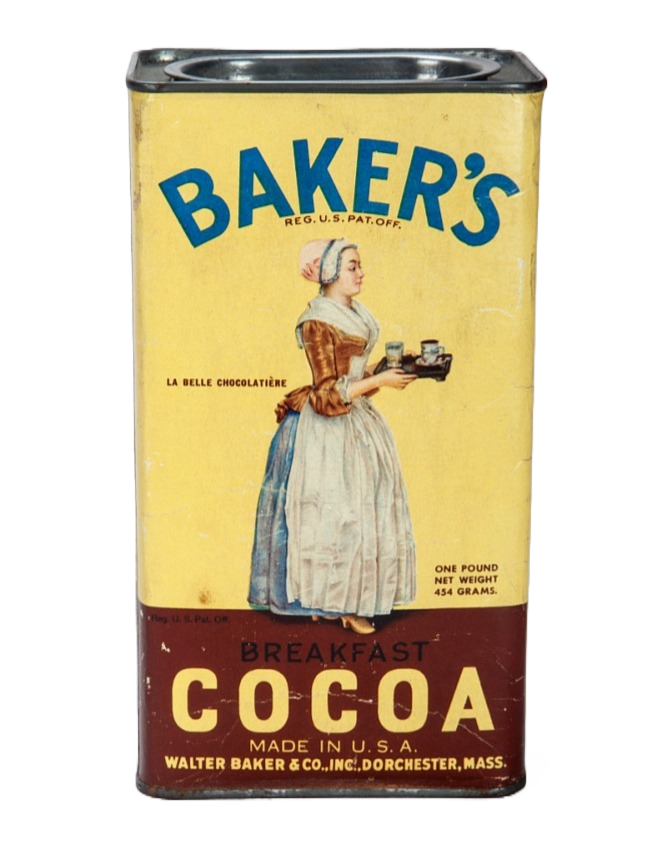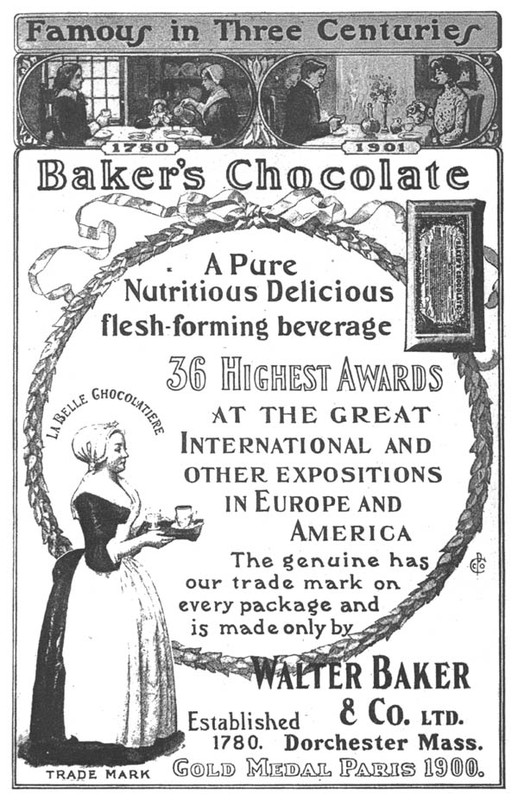“Advertisement for Walter Baker & Co.: “famous in three centuries … Baker’s Chocolate”,” Digital Collections – University at Buffalo Libraries.
Image Citation. https://digital.lib.buffalo.edu/items/show/94952.

Baker’s
“Walter Baker & Company” was born in 1780, when the original creator of the chocolate died and his wife sold the company to Walter Baker. Prior to 1865, the company did not actually manufacture baking chocolate, instead producing three grades of “Drinking Chocolate”: Best, Common, and Inferior. “La Belle Chocolatiere” was trademarked in 1883, under owner Henry Pierce, which was also the time when the chocolate became popular as an ingredient in baking and developed its iconic squares. By 1896, advertisements for Baker’s Chocolate were appearing in approximately 8,000 U.S. newspapers. The company, now coined “Baker’s,” is currently owned by Kraftz Heinz.1

https://www.karosyrup.com/our-history/.
Karo
Corn syrup existed as a generic product well before Karo came to dominate the industry. In 1902, the Corn Products Refining Company introduced Karo Syrup, a clear bottled version of what had originally been sold in barrels. By 1910, Karo Syrup was taking up advertising space anywhere it could, but it particularly became visible in women’s periodicals and cookbook that specifically named the brand as a cursory ingredient. In the early years of World War I, it was promoted as a sugar substitute.2

Image courtesy of the Science History Institute and Wikimedia
Rumford
Horsford and George Wilson founded Rumford Chemical Works in 1859. In 1861, Horsford published The Theory and Art of Breadmaking: A New Process Without the Use of Ferment, and in 1864 he obtained a patent for self-rising flour which used sodium bicarbonate as its leavener. Ten years after its founding, Rumford Chemical Works succeeded in producing “an already-mixed leavening agent” – what would eventually become baking powder. Originally it was named “Horsford’s Yeast Powder” but shortly thereafter was changed to “Rumford Baking Powder.” The company published a Cook Book, seen above, in 1910, with assistance from Fannie Farmer, the famous author of The Boston Cooking-School Cook Book of 1896.3

https://commons.wikimedia.org/wiki/File:Wesson_Oil_ad.jpg
Wesson
Wesson Oil was a branch of the “Southern Cotton Oil Company,” founded in 1887. In 1899, David Wesson, a food chemist, developed a process for “deodorizing cottonseed oil,” which produced the first commercially available all-vegetable shortening made from cottonseed. The product itself was originally marketed as “Wesson Snowdrift,” and was produced in both liquid and solid form. Throughout the early 1900s, “Wesson Oil” advertisements appeared as a healthier alternative to a nation that was eager to venture farther into domestic science.4
- Goldstein, D.; Mintz, S.; Krondl, M.; Rath, E.; Mason, L.; Quinzio, G.; Heinzelmann, U. (2015). The Oxford Companion to Sugar and Sweets. Oxford University Press. p. 45.
- Weinstein, Jay (2007). "Karo Syrup". In Smith, Andrew F. (ed.). The Oxford Companion to American Food and Drink. Oxford. p. 339.
- "Development of Baking Powder: National Historic Chemical Landmark". ACS Chemistry for Life. American Chemical Society.
- https://www.purewesson.com/our-story/
